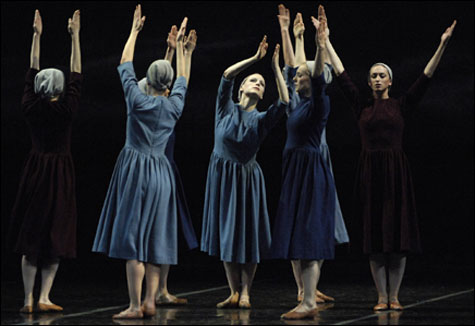
DARK ELEGIES A simple grace, here performed with simple grace.
|
Boston Ballet closed its 2007–2008 by revisiting some pieces and choreographers it hasn’t performed in the Mikko Nissinen era: George Balanchine’s Concerto Barocco, which it last did in 1988; Antony Tudor’s Dark Elegies, which it’s never done (the company’s last Tudor work was Jardin aux lilas, in 1990); and Twyla Tharp’s In the Upper Room, which it’s had on three programs, most recently in 1995. Memory can play tricks: I “recall” In the Upper Room as being a Big Bang of a dance, but I see that the two mid-1990s reviews I wrote expressed reservations about its ontology. Concerto Barocco, on the other hand, looks simpler and deeper every time I see it, and these performances — I caught all six — were tighter than the ones from 1988. Whether Boston Ballet’s Tudor style has improved I wouldn’t venture to say, but Dark Elegies was a tearjerking effort from a company that hasn’t done him in 18 years.

Concerto Barocco was conceived in New York but first saw the light of day in Rio de Janeiro, as an American Ballet Caravan presentation in 1941, on the same tour that birthed Ballet Imperial (now Tchaikovsky Piano Concerto No. 2). It was part of the very first New York City Ballet evening, on October 11, 1948, but it wasn’t till 1951 that the original fantastical costumes were dropped in favor of practice clothes, and only in the 1960s, as Nancy Goldner reminds us in Balanchine Variations (just out from the University Press of Florida), did the women exchange their black tunics for white. Now it’s hard to imagine the work any other way.
The music, Bach’s Double Violin Concerto, is so elemental, so obvious, it seems to be writing itself. So does Balanchine’s choreography. In the first-movement Vivace, two groups of four women each form the backdrop for two solo women who move in unison, in mirror image, in canon. It has the look of submission to the goddess — Diana rather than Venus. The Largo — an infinity of human feeling in just 50 bars — has hardly begun before one woman runs off and a man runs on to dance with the other in Balanchine’s alphabet of arabesques; they twine through the bridesmaid eight as if playing “In and Out the Window” and form a daisy chain like the dancers in the slow movement of Ballet Imperial. Toward the end of the movement, the second woman slides on, diagonally, the man runs off, the two women confer briefly (a warning?) in the same position with which the Largo started, and it begins again, the second woman leaving and the man coming back on. The concluding Allegro brings the backdrop forward, the two soloists growing dueling-passé competitive — over the man? — as well as complementary. Of the man we see nothing further.
The star of this production was the eight-member corps, whose ensemble and idiom eclipsed what the company did in 1988 and didn’t suffer, if memory serves, by comparison with the New York City Ballet performances I saw in 2003 and 2006: they hopped in unison, their tricky Allegro arm movements were crisp, and their phrasing was hypnotic. The opening-night “violins,” Romi Beppu and Melissa Hough, weren’t ideally matched, Hough tough and jazzy, Beppu soft and classical and without big extension, but their interaction was sisterly. (Sunday afternoon Hough was replaced by Misa Kuranaga, and she and Beppu were soft and classical together.) In the Largo, Roman Rykine didn’t duck and turn smoothly under Beppu’s arm, there was some daisy-chain bumping, and the seven big arabesque lifts struggled. Beppu was, however, pristine in the big attitude turn (after all those arabesques) that ends the movement.
In the second cast, Melanie Atkins danced with greater clarity and abandon, especially in her brief fling of a third-movement solo. She has “Balanchine legs”: offered, with teasing good humor, and at the same time withheld. Lia Cirio was substantial, not as nuanced or witty, but generous in the air, and the steps in her double-pirouette-and-developpé-to-the-side series were right on the beat. She and Pavel Gurevich — a regal, heroic partner (sign him up for Ballet Imperial) —made the arabesque lifts sing. The two violin soloists, Michael Rosenbloom and Lisa Crockett, and the rest of the Boston Ballet Orchestra under Jonathan McPhee managed to be period-sensitive and romantic.
Dark Elegies was created in 1937 for London’s Ballet Rambert; American Ballet Theatre gave the American premiere three years later. Set to texts by 19th-century German poet Friedrich Rückert, Gustav Mahler’s five Kindertotenlieder (“Songs on the Death of Children”) — sung here by baritone Philip Lima, who was seated downstage left — weave grief and denial and submission to fate: a dead child’s eyes become stars in the sky; the singer decides his children have only walked on ahead and he’ll catch them up “on the heights”; the singer would not have let his children go out in the storm, but he was overruled, and now they rest in God’s shelter. Mahler’s tonalities reflect the poetry’s ambivalence; the third song doesn’t even resolve.